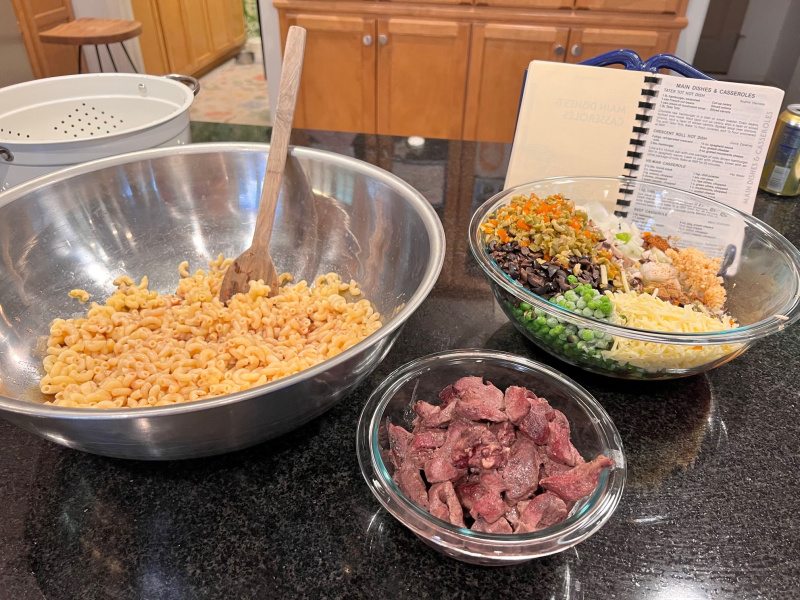Given that one of the main features of adulting is having to figure out what to have for dinner, I ventured back into the “Main Dishes & Casseroles” section of The Joy of Sharing to look for a dish I could make with the thawed venison steak in my garage fridge. Thank goodness for a second fridge and two deep freezes during this project! Though we live in town now (yay for take-out), both my spouse and I grew up in the country, thus internalizing strategies necessary for grocery shopping when you live far from the store. While we’ve consciously dropped many of those techniques, we still can’t imagine having only one fridge or freezer.
Eventually, I settled on Pat Beyer’s recipe for “He-Man Casserole,” planning to replace the round steak with venison.
Given the size of the casserole produced by this recipe, I’m certain Pat Beyer must have owned multiple cold-storage appliances too.
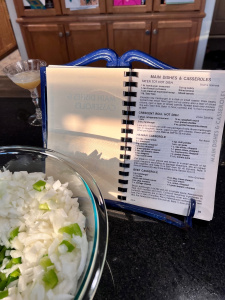
Preparation and preparation and preparation…
As in previous recipes, I was concerned about overcooking the meat to the point of inedibility, given that I was instructed to cut it into 1-inch pieces and brown it, then bake it for 45 minutes. So, I very lightly seared it and hoped for the best. I boiled water for the three cups of elbow macaroni (which was one box) and proceeded to start the chopping.
This recipe was so big it took all evening, with short breaks to make our daughter a quick dinner and get her to bed. I know I’m a slow cook, but I wasn’t prepared for the temporal investment, despite the indication that it would eventually serve ten to twelve people. I had to chop three onions, a green pepper, two cups of olives, and a cup of mushrooms, as well as measure and mix fifteen total ingredients.
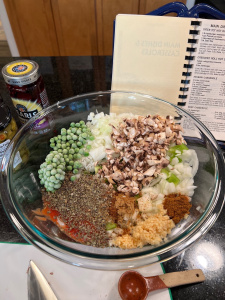
As I write it out, it doesn’t sound like it should have been so overwhelming. But the mixture became so large that I again had to get out the big stainless steel mixing bowl, and I had no idea what dish I could use to bake this giant casserole.
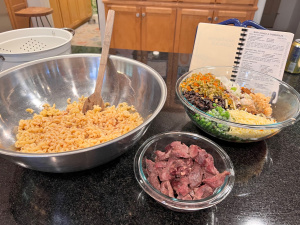
I started wondering how big Pat Beyer’s family must be. I also had a huge pile of dishes afterward, and washing dishes is my least favorite but most frequently performed domestic task.
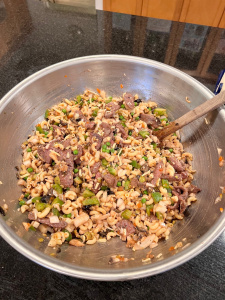
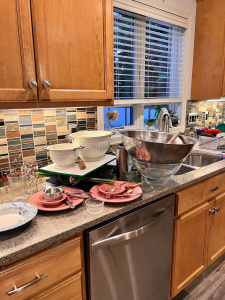
Once again, I had a few questions about the instructions and needed to take some light liberties. I questioned why none of the vegetables were sauteed prior to being baked, as well as whether “3 cloves, chopped,” referred to cloves of garlic or the aromatic similar to nutmeg and allspice. I decided to use frozen peas too, again, given my desire to limit my family’s exposure to BPA. Since little seasoning was prescribed for the size of the mixture (the ambiguous cloves, two teaspoons of oregano, and one of cumin and chili powder), I made the command decision to add two teaspoons of salt and pepper, as well as to use Clamato for the one and a half cups of tomato juice. Later, when the mixture was finished, I followed Pat’s suggestion to add more tomato juice if the mixture seemed dry. It certainly did, given the lack of any sautéing oil, only 1.5 cups of juice, and the volume of dry ingredients. I had enough casserole for two 9 x 13-inch pans, and I decided to add some shredded quesadilla-blend cheese to the top.
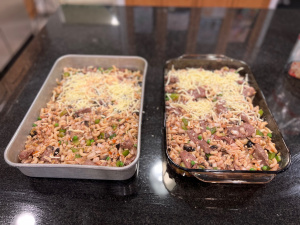
Reflections: Taste and Title
Taste: Luke and I finally ate at about 10 pm, and it was pretty tasty. I wouldn’t rule out making it again and continuing to experiment with more seasoning. I liked how vegetable-heavy and unprocessed it was, which is not typical in casserole recipes I’ve been perusing. Luke added a few Bugles (I know, I know…who has purchased Bugles in the past 10 years? I’m not even sure where he found them) to the top for crunch, and we both added hot sauce for kick. I brought some to my parents and gave the second pan to my sister’s family. My mom liked it, though she thought the venison was tough due to microwave reheating. My sister’s family loved it! She warmed it up in the oven, and both adults thought it was delicious. Her two-year-old ate a ton of it, and even the neighbor girl who stayed for dinner after a playdate enjoyed it. Many thumbs up from all of them!

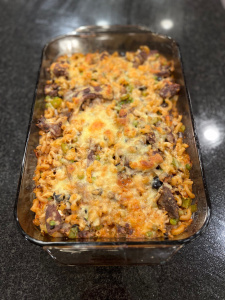
Title: However, the recipe’s title is a point of contention for me. I have not yet been able to find a history for a “he-man casserole,” nor a replica of this exact recipe (others of this name seem to have ham, ground beef, or tuna and do sauté the vegetables), and given the nature of compiled cookbooks to not include original recipes, I assume Pat didn’t create it or name it. Google prods me toward recipes it considers similar, with titles like “The Best Husband’s Delight Casserole” and “John Wayne Casserole.” A brief article on Tasting Table’s website by Autumn Swiers provides a description of John Wayne’s casserole, originally a simple egg and cheese dish he submitted to a 1979 fundraising cookbook collection of dishes beloved by celebrities, called Cooking with Love from Cara and Her Friends” by Cara Connery. Over the years, it’s transformed into a heartier casserole with ground beef and vegetables as a base layer with a spicy, creamy, cheesy topping. What’s especially interesting here is that the eponymous casserole reflects not just a dish John Wayne enjoyed, but rather became illustrative of who John Wayne appeared to be and the characters he played. As Swiers says, “the actor portrayed a cowboy or similar rugged idol of pastoral masculinity in nearly 150 different movies across the 20th century. . . . He was the platonic ideal of a cowboy—and it’s after him that the casserole worthy of a true adventurer is named” (see https://www.tastingtable.com/1212543/whats-in-john-wayne-casserole-and-did-the-star-invent-it/).
He-Man was a 1980s toy action figure and comic book superhero, the protagonist of the cartoon series He Man and the Masters of the Universe. I loved this show as a child, particularly the episodes featuring his twin sister, She-Ra. Like John Wayne, He-Man is a classic picture of masculinity, even named with two masculine-signifying words, the third-person personal pronoun “he” and the noun “man,” pointing to an adult male human. He-Man has superhuman strength and athleticism, rippling muscles, and a giant sword. Dolph Lundgren, of Rocky IV fame, even played He-Man in the 1987 live -action film Masters of the Universe (also staring Frank Langella and a very young Courteney Cox! Who knew? I did not see that one).
He-Man is hyper-masculine and super-sized, as is his eponymous casserole. As I noted above, Pat Beyer’s version is also super-sized, with fifteen different ingredients and enough casserole to fill two 9 x 13-inch pans. In fact, I found a recipe for a different He-Man casserole on a food, gardening, and book blog called “Big Food Etc.,” which seems appropriate! The authors note that they, like me, have not found a history of the casserole or explanation for the name, and also note its tremendous size: “This makes a lot—you might need two casserole dishes to fit it all comfortably” (see https://www.bigfoodetc.com/2021/12/28/a-big-food-favorite-recipe-he-man-casserole/).
The ingredients also reflect stereotypical associations of masculinity—steak, pasta, and lots of cheese and veggies combine to create a hearty, filling meal—one fit for a cowboy like John Wayne, a superhero like He-Man, and others, usually men, who need fuel to remain strong as they tackle tough physical work. In Velva in the 1980s, this would include farming, of course, but also working in other industries in the area, like CF Industries (agricultural fertilizer production), Archer Daniel Midland (ADM—canola processing), the William J. Neal Station electrical generating power plant and lignite coal mine (both closed in 1985), and Verendrye Electric Cooperative. Food consumption is gendered, as sociologist Shelley L. Koch explains in Gender and Food: A Critical Look at the Food System:
In Western cultures, foods associated with women and femininity are “light” foods such as fruits, vegetables, pasta, and sweets, while foods associated with men are “heavy,” a category that includes energy-dense foods such as meat and starches, which symbolize strength and masculinity. The light/heavy split mirrors the body/mind dichotomy, in which the irrational body (including food and sexual appetites) are considered female, while the rationale and in-control mind is equated with the male. The rationale (masculine) person eats for power, strength, and without emotion, while emotional (feminine) eating is an attempt to control bodily urges through restriction and denial of hunger. Hence, the distinction between fruit and vegetables (light, insubstantial) and meat (strong, powerful). (79-80)
The way this dichotomy plays out in the United States can be constricting and harmful. I’ve been surrounded by this paradigm my entire life and have been seen and experienced its constriction and harm. I’m really sick of it, and though I loved the He-Man cartoon as a child and undoubtedly will see the new live-action version set to come out sometime next year, I don’t appreciate a reminder that this dish is not something appropriate for me to eat. Or at least not to eat more than a small portion. Believe me, I don’t need to be reminded; I’m hyper-aware of the gendered expectations present in every single aspect of every interaction I have with food. It’s exhausting.
Contributor
At seventeen recipes, Pat Beyer is tied with Mardi Schock for the honor of contributing the most recipes to The Joy of Sharing. Pat’s contributions include:
Water Chestnut Appetizers Cheese Balls Sour Cream Twists
Frosted Cashew Cookies Date-Nut Cupcakes Cranberry Cake
Rice Broccoli Casserole Old-Fashioned Baked Beans Cream Fudge
Wild Rice Casserole Teriyaki Steak Baked Chicken Breast
Cauliflower Salad Rice-Shrimp Salad Marinated Relish Salad
French Dressing He-Man Casserole
Pat is not listed in the McHenry County book, but while searching online, I was able to discover that she was born in 1936 in Makoti, ND, to Grant and Grace Shaw, and married Wally Beyer in 1955. They had three children: Wanda, Janelle, and Jonathon. Wally Beyer was the manager of the Verendrye Electric Cooperative from 1968-1993, during which the couple lived on a farm north of Velva, and later served as administrator of the US Rural Electrification Administration for six years in the 1990s. During this period, the couple lived in Washington D.C., and later moved to Bismarck, ND, in 1999, when Wally retired. Pat died in 2007, Wally in 2015.
This post is part of an ongoing series in which I make and reflect on recipes and the people who contributed them to the 1985 Oak Valley Lutheran Church compiled cookbook, The Joy of Sharing.

